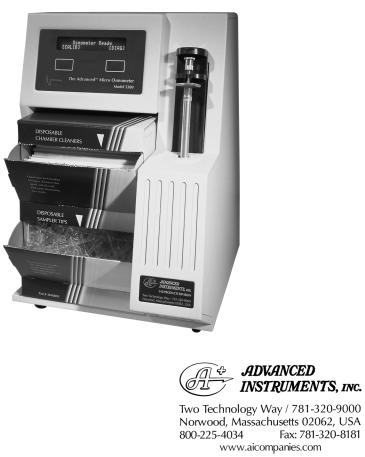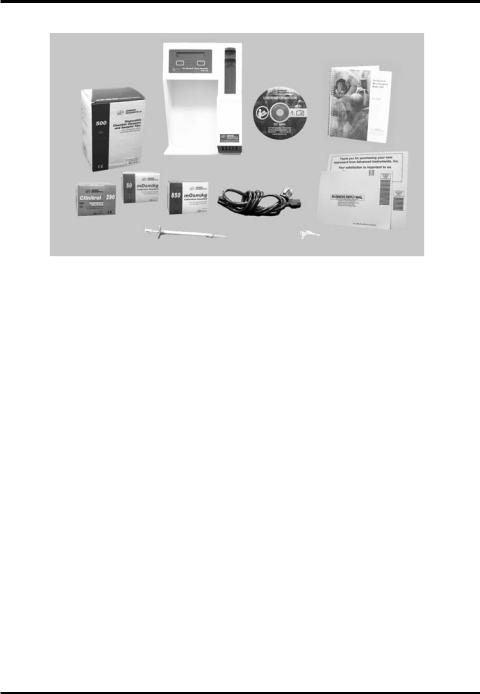Advanced 3300 User manual

The Advanced® Micro-Osmometer
Model 3300
User’s Guide
3305 Rev20 051109

Advanced® Micro-Osmometer Model 3300 User’s Guide
Copyright
This user’s guide is copyrighted by Advanced Instruments, Inc. with all rights reserved. Under copyright laws, this guide may not be reproduced in any form, in whole or part, without the prior written consent of Advanced Instruments.
© 2002 Advanced Instruments, Inc.
Windows® is a registered trademark of Microsoft Corporation in the United States and other countries. Intel® is a registered trademark of Intel Corporation in the United States and other countries. All other trademarks are the property of Advanced Instruments, Inc.
Advanced Instruments has reviewed this guide thoroughly. All material contained within is believed reliable, but the accuracy and completeness are not guaranteed or warranted, and are not intended to be representations or warranties concerning the product described.
Hot-Line® Service
If you have any questions or problems regarding the proper operation of your instrument, please contact our Hot-Line Service department:
•800-225-4034 (toll-free within the USA and Canada)
•+US 781-320-9000 (elsewhere)
•781-320-0811 (fax)
ii


 Table of Contents
Table of Contents
|
|
Parts & Accessories |
v |
Calibrators & Standards |
vii |
Safe Use |
ix |
Symbol conventions |
ix |
General cautions |
x |
Foreword: Theory and Technique |
xiii |
Chapter 1 — Installation & Setup |
1 |
Step 1 — Find a location for your instrument |
1 |
Step 2 — Unpack your instrument |
1 |
Step 3 — Obtain additional items |
2 |
Step 4 — Power up your instrument |
2 |
Step 5 — Set your date and time |
4 |
Step 6 — Check your initial calibration |
4 |
Step 7 — Proceed to instrument operation |
5 |
Figure 1: Model 3300 Micro-Osmometer and Accessories |
3 |
Table 1: Model 3300 Micro-Osmometer Packing List |
3 |
Chapter 2 — Instrument Operation |
7 |
Hazardous material cautions |
7 |
Function of major components |
7 |
Sample handling |
12 |
Standards & controls |
12 |
Sample test procedure |
13 |
Sample test errors |
14 |
Recall results |
15 |
Repeatability tips |
15 |
Statistics |
16 |
|
|
iii

Advanced® Micro-Osmometer Model 3300 User’s Guide
Changing operating settings |
17 |
|
Using a barcode scanner with the Model 3300 |
20 |
|
Using a printer with the Model 3300 |
21 |
|
Using the Model 3300’s RS-232 port |
21 |
|
Instrument software update |
22 |
|
Figure 2: Model 3300 |
Components and Controls |
8 |
Figure 3: Model 3300 |
Back Panel |
10 |
Figure 4: Sample Cell Tips and Sample Levels |
13 |
|
Table 2: Barcode Port Connections |
11 |
|
Chapter 3 — Calibration |
23 |
Calibration procedure |
23 |
Calibration notes |
24 |
Chapter 4 — Troubleshooting & Service |
27 |
Service & maintenance cautions |
27 |
Obtaining service |
29 |
Troubleshooting checks |
30 |
Internal diagnostics |
30 |
Fuse replacement |
34 |
Chamber cleaning |
35 |
Sample plunger replacement and calibration |
36 |
Figure 5: Fuse Replacement |
35 |
Figure 6: Sample Plunger Replacement and Calibration |
37 |
Appendices |
|
Appendix A: Troubleshooting Table |
39 |
Appendix B: Product Specifications |
45 |
Appendix C: Regulatory Notices |
47 |
Appendix D: Warranty and Warranty Duties |
51 |
Appendix E: Supplemental RS-232 Information |
55 |
Appendix F: Symbol Definitions |
57 |
Appendix G: Service Log |
61 |
Index |
63 |
iv


 Parts & Accessories
Parts & Accessories
To order parts and accessories, contact the Advanced
Instruments Customer Service Department:
•800-225-4034 (toll-free within the USA and Canada)
•+US 781-320-9000 (elsewhere)
•781-320-3669 (fax)
PART DESCRIPTION |
PART NO. |
|
|
20-µL Sampler |
3M0825 |
|
|
Replacement Sample Probe |
330700 |
|
|
Micro-Sample Test Kit (500 tests) |
3MA800 |
|
|
Sampler Plunger Wires (2) |
3M0828 |
|
|
Thermal Printer with Interface Cable, Operation Manual, |
210555_NA |
Thermal Paper Roll, and Printer Power Supply (100-120 |
|
VAC) |
|
|
|
Thermal Printer with Interface Cable, Operation Manual, |
210555_EU |
Thermal Paper Roll, and Printer Power Supply (230 VAC) |
|
|
|
Printer Paper (5 rolls) |
3D3835 |
|
|
User’s Guide |
3305 |
|
|
Service Manual |
3305SM |
|
|
Serial Cable |
RS232-Cable |
|
|
Software Upgrade* |
330990 |
|
|
Barcode Scanner |
330016 |
|
|
* Note: 330990 upgrade kit comes with a 3-meter serial cable #330053.
v

Advanced® Micro-Osmometer Model 3300 User’s Guide
Notes:
vi


 Calibrators & Standards
Calibrators & Standards
To order calibrators and standards, contact the Advanced Instruments Customer Service Department:
•800-225-4034 (toll-free within the USA and Canada)
•+US 781-320-9000 (elsewhere)
•781-320-3669 (fax)
DESCRIPTION |
PART NO. |
|
|
ClinitrolTM Reference Solution (10 2-mL ampules) |
3MA029 |
|
|
Protinol® 3-Level Protein Control Kit (9 3-mL bottles, 3 of |
3MA028 |
each level) |
|
|
|
Renol™ Urine Osmolality Controls (2 levels) |
3LA085 |
|
|
5-Value Osmolality Linearity Set (10 5-mL ampules, 2 of |
3LA028 |
each value) |
|
|
|
50 mOsm/kg Calibration Standard (10 2-mL ampules) |
3MA005 |
|
|
850 mOsm/kg Calibration Standard (10 2-mL ampules) |
3MA085 |
|
|
vii

Advanced® Micro-Osmometer Model 3300 User’s Guide
Notes:
viii


 Safe Use
Safe Use
To reduce the risk of bodily injury, electric shock, fire, and damage to your instrument, please read and observe the precautions in this User’s Guide.
•If the product is used in a manner not in accordance with the equipment design, operating instructions or manufacturer's recommendations, the operation of the product may be impaired to the extent that a safety hazard is created.
•Do not attempt to perform electrical work if you are not fully qualified. This manual is not a substitute for electrical training.
Symbol conventions
The exclamation point within an equilateral triangle is intended to alert the user to the presence of important operating and maintenance (servicing) instructions in the literature accompanying this product.
The lightning flash with arrowhead symbol within an equilateral triangle is intended to alert the user to the presence of uninsulated dangerous voltage within the product's enclosure that may be of sufficient magnitude to constitute risk of electric shock to persons.
The static symbol within an equilateral triangle is intended to alert the user to the presence of internal components that could be damaged by static electricity.
This static symbol is intended to alert the user to the presence of a specific component that could be damaged by static electricity.
ix

Advanced® Micro-Osmometer Model 3300 User’s Guide
This symbol indicates the presence of alternating current (AC).
This symbol indicates the presence of a fuse.
This symbol indicates the presence of protective earth ground.
General cautions
•This product should be operated only with the type of power source indicated on the product’s electrical ratings label. Refer to the installation instructions included with the product.
•If the power cord provided is replaced for any reason or if an alternate cord is used, the cord must be approved for use in the local country. The power cord must be approved for the product’s listed operating voltage and be rated at least 20% greater than the ampere ratings marked on the product’s electrical ratings label. The cord end that connects to the product must have an IEC 60320 connector.
•Plug the product into an approved grounded electrical outlet.
•Do not disable the power cord’s grounding plug.
•If an extension cord or power strip is used, make sure that the cord or strip is rated for the product, and that the total ampere ratings of all products plugged into the extension cord or strip do not exceed 80% of the cord’s or strip’s rating limit.
•Route power cords so that they will not be walked on, tripped on, or pinched by items placed upon or against them. Pay particular attention to the plug, electrical outlet, and the point where the cord exits the product.
•Do not pull on cords and cables. When unplugging cords or cables, grasp the corresponding connector.
x

Safe Use
•Do not install or use this product in any area subject to extreme short-term temperature variations, or locations that exceed the specified operating environment temperatures.
•Never use this product in a wet area.
•To avoid injury or fire hazard, do not operate this product in an explosive atmosphere.
•Do not install or use the product on an unstable, non-level work surface.
•Do not operate this product with the covers removed or unsecured.
xi

Advanced® Micro-Osmometer Model 3300 User’s Guide
Notes:
xii


 Foreword
Foreword
Intended Use
Advanced® Osmometers use the technique of freezing-point depression to measure osmolality. Osmolality is the total solute concentration of an aqueous solution. Osmometers measure the number of solute particles irrespective of molecular weight or ionic charge. This information is useful to the following disciplines:
Clinical, emergency and sports medicine Medical research
Biotechnology and pharmaceutical research and manufacturing
Food and beverage manufacturing Environmental research and monitoring Academic research
Industrial applications
When used by a trained operator in clinical applications, the osmometer provides results that assist in establishing the proper diagnoses and treatments for patients with disorders involving water and electrolyte imbalances. Osmometers will test virtually any biological fluid including, but not limited to, whole blood, plasma, urine, feces, sweat, and tissue homogenate. Operation of the instrument is deemed to be low-complexity under CLIA and FDA guidelines.
xiii

Advanced® Micro-Osmometer Model 3300 User’s Guide
Principles of Freezing-Point Osmometry
When a solute is dissolved in a pure solvent, the following changes in the solution's properties occur:
•the freezing point is depressed,
•boiling point is raised,
•osmotic pressure is increased, and
•vapor pressure is lowered.
These are the so-called "colligative" or concentrative properties of the solution which, within reasonable limits, change in direct proportion to the solute concentration; in other words, the number of particles in solution.
Of the colligative properties, measurement of the freezing point allows the concentration of an aqueous solution to be easily determined with great precision.
The freezing point of pure H2O is precisely +0.010°C. One mole of a non-dissociating solute such as glucose (where the solute does not dissociate into ionic species, but remains intact), when dissolved in 1 kilogram (kg) of water will depress the freezing point by 1.858°C. This change is known as the freezing point depression constant for water. The freezing point depression also depends upon the degree of dissociation of the solute. If the solute is ionic, the freezing point is depressed by 1.858°C for each ionic species. For example, if one mole of sodium chloride were to completely dissociate into two ionic species (Na+ and Cl-) in 1 kg of water, the freezing point would be depressed by 3.716°C. However, dissociation is never complete. Interference between solute molecules reduces dissociation by a factor called the osmotic coefficient.
xiv

Foreword
In a simple solution such as glucose or sodium chloride in water, the freezing point can be measured and the unit concentration easily determined from an equation or a reference table. However, the equation is unique for each solute. In a more complex solution, all ionized and non-dissociated species contribute to the freezing-point depression and the concentration of each solute cannot be easily determined.
Each of the colligative properties has a similar problem, and though each of the colligative properties changes in direct proportion to the solute concentration, each requires a different mode & unit of measurement. Osmolality is a common unit of concentration measurement that can be used to relate all the colligative properties to each other, and to other concentration units. Because of its universality, most osmometry applications regularly use osmolality, expressed as "mOsm/kg H2O", as the common unit of concentration rather than applying further conversion factors.
Instrumentation
Advanced Osmometers are devices for the determination of the concentration of solutions by means of freezing-point measurement.
Advanced Osmometers utilize high-precision thermometers to sense the sample temperature, to control the degree of supercooling and freeze induction, and to measure the freezing point of the sample. They can routinely determine differences of ±1 mOsm/kg H2O.
Freezing-Point Thermodynamics
The quickest and most precise way to measure the freezing point of a solution is to supercool it several degrees below its freezing point. It is unstable in this state, and a mechanical agitation induces crystallization. The heat of fusion suddenly liberated causes the sample temperature to rise toward a plateau temperature, where a liquid/solid equilibrium occurs. The equilibrium temperature is, by definition, the freezing point
xv

Advanced® Micro-Osmometer Model 3300 User’s Guide
of the solution. Managing the plateau temperature for precise measurement is the basis for several patents issued to Augustus Fiske.
The time over which liquid/solid equilibrium develops and is maintained, is a function of the speed with which the heat-of-fusion is liberated vs. the speed it is transferred away, or absorbed, by the surrounding environment. This ratio can be slowed and the equilibrium time stretched, to give a distinct plateau height measurable to 0.001°C.
Sensitive thermistor probes monitor the sample temperature and control the thermoelectric cooling element. Microprocessor control and automated operation minimize imprecision due to operator technique.
The following Standard Freezing Curve illustrates the temperature of a sample as it progresses through the freezing cycle and shows the action of the instrument at each stage of the cycle.
Standard Freezing Curve
Definitions
Solution: A homogeneous mixture of solute and solvent in which the solvent is usually the major component, and the solute is the minor component.
Concentration: The ratio of solute to a given amount of solvent (molal), or ratio of solute to solution (molar).
xvi

Foreword
The amount of solute is usually expressed in terms of moles, i.e., gram molecular weights. One mole = 6.028 x 1023 molecules (Avogadro's number). One mole of glucose (180.2 g) and one mole of sodium chloride (58.4 g) each contain Avogadro's number of molecules.
Common units of concentration are:
•Molality: Moles of solute per kilogram of pure solvent.
•Osmolality: Osmols of solute particles per kilogram of pure solvent. As noted above, most ionic solutes do not completely dissociate. Osmolality is a unit of concentration that takes into account the dissociative effect. Osmolality is usually expressed in mOsm/kg H2O. One milliosmol (mOsm) is 10-3 osmols. Osmolality is defined as:
Osmolality = φnC = osmol kg H2O
where:
ø = osmotic coefficient, which accounts for the degree of molecular dissociation.
n = number of particles into which a molecule can dissociate. C = molal concentration of the solution.
•Molarity: Moles of solute per liter of solution.
•Osmolarity: Osmols of solute particles per liter of solution. Although molarity and osmolarity may be common units of measurement in other branches of chemistry, they are not used in osmometry because the ratio of solute to solution is not linear. Molality and osmolality are linear, independent of the effect of temperature and volume displaced by solute. A calculated conversion between units of molality and molarity is complex and generally unnecessary when the terms are properly understood.
xvii

Advanced® Micro-Osmometer Model 3300 User’s Guide
Freezing Point/Melting Point: The temperature at which the liquid and solid phases of a substance will remain together in equilibrium.
Freezing-Point Depression: When a solute is added to a solvent, the freezing point of the solvent is lowered. In aqueous solutions, one mOsm of solute per kilogram of water depresses the freezing point by 1.858 millidegrees Celsius (m°C).
Supercooling: The tendency of a substance to remain in the liquid state when cooled below its freezing point.
Crystallization Temperature: Aqueous solutions can be induced to freeze (i.e., crystallize) most reliably when supercooled. When supercooled, agitating the solution (freeze pulse) induces crystal formation. The crystallization temperature is the temperature at which crystallization is induced. During crystallization, the heat of fusion raises the temperature of the sample to an ice/water freezing-point plateau.
Heat of Fusion: The heat released when the mobile molecules of a liquid are frozen into rigid ice crystals.
Freezing-Point Plateau: The constant temperature maintained during the time that ice and liquid exist in isothermal equilibrium after crystallization occurs.
xviii

1 Installation & Setup
In order to set up your instrument properly, it is important that you read and follow the steps in this section. Please follow these steps carefully and be sure to read Chapter 2 — Instrument Operation before attempting to run tests on your instrument.
Step 1 — Find a location for your instrument
When choosing a location for your new osmometer, be sure to meet the following criteria.
• Adequate space. The dimensions of the instrument are 13 × 10.5 × 15.5 inches (26.7 × 33 × 39.4 cm). Be sure to keep your workplace free of debris, especially near the front of the instrument where proper ventilation is needed.
•Electric outlet availability. Your instrument will need to operate within five feet of a properly grounded, three-prong electrical outlet capable of continuously supplying 1 ampere at 200-250V to 1.25 amperes at 100-130V. If the instrument is not grounded properly, its operation may be impaired and a safety hazard may exist. Therefore, be sure to test the outlet and record the results before operating your instrument.
Step 2 — Unpack your instrument
To unpack your osmometer, take the following steps.
a.Carefully unpack your osmometer, accessories and supplies and inspect them for shipping damage. Use the enclosed packing list to verify that all items have been received.
1

Advanced® Micro-Osmometer Model 3300 User’s Guide
b.Save your osmometer's shipping boxes and packaging material in case future transport of the instrument becomes necessary.
c.If any item on the packing list appears to be missing from your shipment, please search carefully through and under all packing materials. If the item is not found, notify your receiving department immediately. Advanced Instruments can only be responsible for items reported missing within 10 days of a shipment’s arrival.
d.If you receive any damaged items, save the cartons and packing material those items came in for inspection by the insurer. The carrier, dealer, and Advanced Instruments must be notified within 24 hours in order for your warranty and insurance to apply. Have the transportation company inspect items, fill out a “Report of Concealed Damage,” and file your claim. Then, notify Advanced Instruments immediately for repair or replacement.
e.Fill out the postage-paid “(U.S.A. Only)” warranty card enclosed. Mark the appropriate boxes if you wish to receive additional information. Customers outside of the United States may fax the warranty card to 781-320-8181.
Step 3 — Obtain additional items
Soft, no-lint, non-ionic paper tissues are needed for wiping the sample cells prior to testing. Please be sure that you have an adequate supply on hand before attempting to run tests on your instrument.
Step 4 — Power up your instrument
Turn your instrument on by pushing the rocker-style power switch on the instrument’s back panel into the on ( | ) position.
Each time your instrument is turned on, it automatically runs a oneminute setup and self-diagnostic program. During these diagnostics, your display and printer (if in use) display critical instrument information, such as software version and block and sample probe bin numbers. The first time you power up your osmometer, record the software revision and
2

Installation & Setup
Figure 1: Model 3300 Micro-Osmometer and Accessories
|
|
|
|
|
Quantity |
Part No. |
Description |
||
1 |
3300 |
|
The Advanced® Model 3300 Micro-Osmometer |
|
1 pack |
3MA029 |
Clinitrol™ 290 mOsm/kg Reference Solution |
||
|
|
|
|
(ten 2 mL ampules) |
1 pack |
3MA005 |
50 mOsm/kg Calibration Standard (ten 2 mL |
||
|
|
|
|
ampules) |
1 pack |
3MA085 |
850 mOsm/kg Calibration Standard (ten 2 mL |
||
|
|
|
|
ampules) |
1 kit |
3MA800 |
Micro-Sample Kit: includes 500 disposable |
||
|
|
|
|
sample cells (tips) and 500 chamber cleaners |
2 |
3D3185 |
Operator/Supervisor Keys |
||
1 |
3MO825 |
20-µL Sampler |
||
1 |
|
|
|
Power Cord (as specified) |
|
|
|
||
1 |
90P01 |
Advanced® User Information CD-ROM |
||
1 |
3305 |
|
User’s Guide |
|
1 |
3305-6 |
|
Warranty Card |
|
1 |
3D3P021 |
Customer Satisfaction Card |
||
|
|
|
|
|
Table 1: Model 3300 Micro-Osmometer Packing List
3

Advanced® Micro-Osmometer Model 3300 User’s Guide
block and sample probe bin numbers in the Service Log at the end of this user’s guide. Maintaining a record of this information will facilitate any necessary service.
When the self-diagnostics have been completed and the instrument is ready for testing, the display reads “Osmometer Ready”.
NOTE To avoid any misunderstanding that might arise due to an unfamiliar display language, all displayed messages may be changed from English to several other languages. (For language selection instructions, see Chapter 2.)
CAUTION If a power interruption occurs, turn the instrument off at once. Leave it turned off for at least 5 seconds after power has been restored (even if power restoration is immediate).
Step 5 — Set your date and time
If you wish, you may now change your date and time settings by using the instructions found on page 17 of this user’s guide.
Step 6 — Check your initial calibration
Your instrument has been carefully calibrated by the manufacturer, but to verify that this calibration is accurate within your operating environment, run tests on the 290 mOsm/kg reference solution and/or Protinol® biological controls before testing samples. The number and type of tests that you run should be determined by your own laboratory’s standard protocol. Use the operating technique described in Chapter 2 when running these controls.
If you determine that the initial calibration is incorrect, re-calibrate as described in Chapter 3.
NOTE If your Model 3300 has just been moved from a different location, it should be allowed to warm up for 20 to 30 minutes before you run calibration verification tests.
4

Installation & Setup
Step 7 — Proceed to instrument operation
If you have followed the steps outlined in this chapter, your instrument is ready for use. To learn how to operate your instrument, read the next chapter, “Instrument Operation”. We strongly recommend that you read the entire second chapter before attempting to operate your osmometer.
5

Advanced® Micro-Osmometer Model 3300 User’s Guide
Notes:
6

2 Instrument Operation
In order to run your instrument properly, it is important that you read and adhere to the instructions in this section. For information on calibration, see Chapter 3 — Calibration.
Hazardous material cautions
•WARNING: Handle all biohazardous materials according to established good laboratory practices and follow your institution’s exposure control plan. Persons handling human blood and body fluid samples must be trained in blood-borne hazards and observe universal precautions. Universal precautions is an approach to infection control, where all human blood and body fluids are treated as if known to be infectious. Use personal protective equipment such as gloves, gowns, etc., to prevent exposure. Store biohazardous materials in regulated waste containers and dispose of these materials in a safe and acceptable manner that is in compliance with all country, state and local requirements.
•If a biohazardous material is spilled on or inside the equipment, decontaminate the equipment using a 1% bleach solution, or as outlined by those policies and procedures established within your institution.
•To avoid injury or fire hazard, do not operate this product in an explosive atmosphere.
Function of major components
The major components of the Model 3300 Micro-Osmometer are an operating cradle; a sample port to precisely position each sample for the osmolality test; a high-precision thermistor
7
